To maintain perfect deep conditioning, start by evaluating your hair’s needs and choose suitable products. Cleanse with a sulfate-free shampoo, detangle gently, then section your hair for even application. Apply the conditioner thoroughly, focusing on roots and ends, and consider heat to boost absorption. Leave it on for 20-30 minutes, rinse carefully, and seal in moisture with a leave-in. Keeping a consistent schedule ensures healthy, shiny hair—that way, you get the best results every time.
Key Takeaways
- Assess hair porosity and scalp health to select suitable products and tailor the deep conditioning routine.
- Properly cleanse hair, detangle gently, and section hair for even product application and thorough coverage.
- Use heat (cap or warm towel) during deep conditioning for 20-30 minutes to enhance absorption and cuticle opening.
- Rinse thoroughly, seal in moisture with leave-in products, and perform scalp exfoliation to promote scalp health.
- Establish a consistent schedule based on hair porosity, track routine effectiveness, and adjust for optimal hair health.
Assessing Your Hair’s Needs and Choosing the Right Products
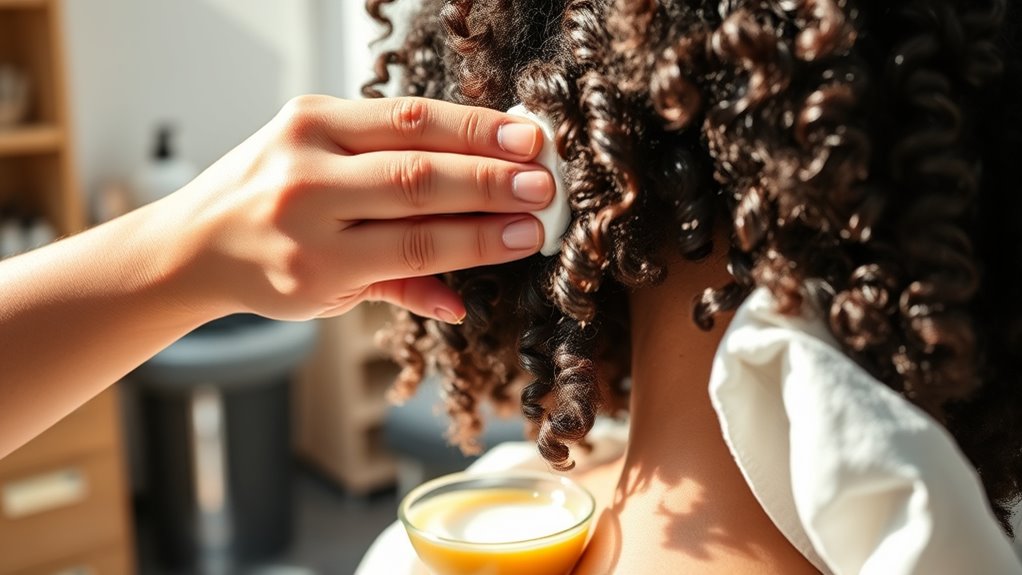
Before selecting a deep conditioning treatment, you need to understand your hair’s specific needs. Start by evaluating your hair porosity—does your hair absorb and retain moisture easily, or does it struggle to hold hydration? Knowing this helps you choose products that balance moisture and protein accordingly. Next, consider your scalp health; a healthy scalp promotes better hair growth and prevents issues like dryness or buildup. If your scalp is oily, opt for lightweight, clarifying conditioners. If it’s dry or sensitive, look for nourishing, soothing formulas. Understanding these factors ensures you pick products that target your unique needs, leading to more effective deep conditioning sessions. Tailoring your choices will improve your hair’s overall health and maintain its natural beauty.
Preparing Your Hair for Deep Conditioning
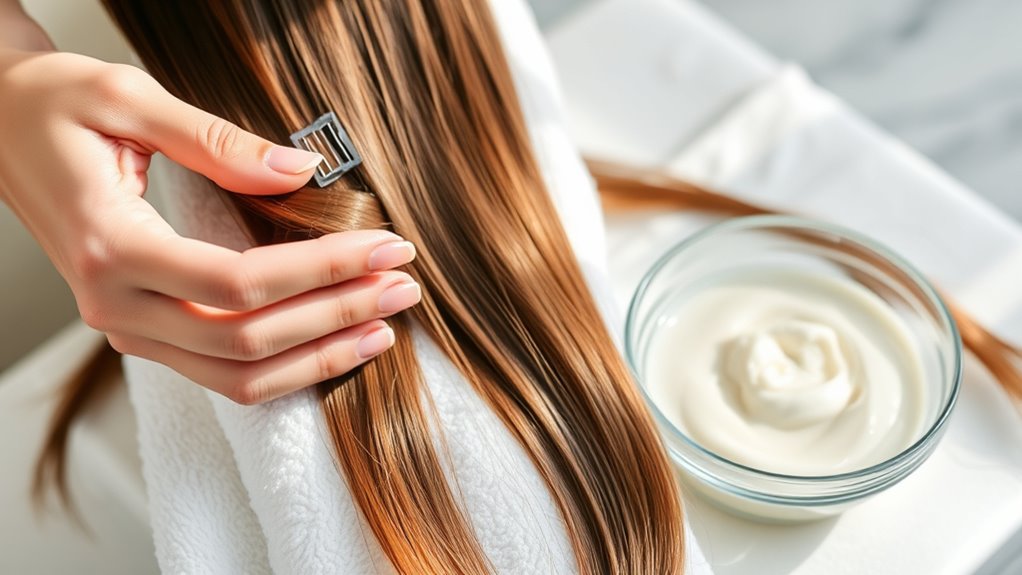
Before applying your deep conditioner, start by cleansing your hair to remove buildup and guarantee better absorption. Next, gently detangle your hair to prevent breakage and achieve a smooth, even treatment. These steps set the foundation for a more effective deep conditioning session. Incorporating a proper maintenance routine can further enhance your hair’s health and ensure long-lasting results.
Cleansing Before Treatment
Proper cleansing is essential to guarantee your deep conditioning treatment works effectively. When your scalp is clean, it promotes better scalp health and allows your hair to absorb nutrients more efficiently. Start by thoroughly washing your hair with a gentle, sulfate-free shampoo to remove buildup and excess oil. This step prepares your scalp for better absorption and prevents product layering issues, which can hinder your treatment’s effectiveness. Focus on massaging your scalp to stimulate circulation and loosen debris. Rinse completely to ensure no residue remains. Clean hair also helps prevent clogged follicles, reducing scalp irritation. Additionally, using the right shampoo can enhance cleansing and improve overall hair health. Once your hair is clean, gently towel-dry to remove excess water before applying your deep conditioner. Proper cleansing sets the foundation for ideal results and healthier, more resilient hair.
Detangling for Smoothness
To guarantee your deep conditioning treatment penetrates evenly and effectively, detangling your hair is a crucial step. Start by using gentle detangling methods, such as a wide-tooth comb or your fingers, to minimize breakage. Work from the ends upward, gradually detangling knots without pulling or stressing your strands. Incorporate hair smoothness techniques like applying a leave-in conditioner or detangling spray beforehand to make the process easier. These products lubricate your hair, reducing friction and preventing damage. Take your time and be patient; rushing can cause unnecessary breakage. Proper detangling not only prepares your hair for deep conditioning but also ensures the treatment penetrates thoroughly, leaving your hair smoother, softer, and more manageable after the process. Utilizing protective styling benefits during detangling can further help maintain your hair’s health and prevent damage.
Applying and Distributing the Deep Conditioner Effectively
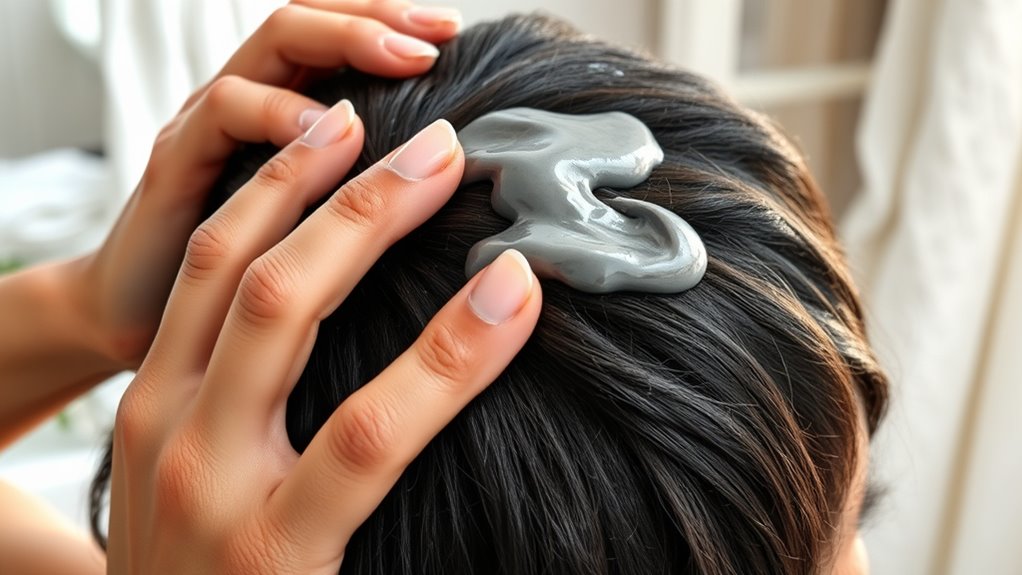
To get the best results, make sure you apply the deep conditioner evenly across all sections of your hair. Use your fingers or a wide-tooth comb to distribute it thoroughly, ensuring every strand receives treatment. Full coverage is key to maximizing the conditioner’s benefits and leaving your hair soft and healthy. Additionally, taking the time to distribute the conditioner properly can significantly improve the effectiveness of your deep conditioning routine.
Even Application Techniques
Applying deep conditioner evenly guarantees every strand benefits from its nourishing properties. You want to ensure your scalp health stays at its best and frizz control becomes easier. Start by sectioning your hair to prevent missed spots. Use your fingertips or a wide-tooth comb to distribute the product thoroughly, reaching the roots and ends equally. This guarantees consistent moisture and reduces uneven dryness. Regularly assess your hair needs to adapt your application for optimal results. Here’s an emotional reminder of your routine:
| Confidence | Nourishment | Transformation |
|---|---|---|
| Feel the power of well-maintained hair | Embrace healthier, shinier strands | Witness your hair’s natural glow |
Proper Distribution Methods
Effective distribution of deep conditioner guarantees every strand receives its full benefits. To achieve this, start by examining the product ingredients—look for nourishing oils and proteins that target your hair’s needs. Use the right application tools, such as wide-tooth combs or fingers, to spread the conditioner evenly from roots to ends. Apply the product in small sections to ensure thorough coverage and prevent missed spots. Work methodically, taking your time to massage the conditioner into each section, enhancing penetration. Avoid rushing, as uneven application can lead to patchy results. Proper dissemination ensures that all strands benefit from the product’s nourishing ingredients, resulting in healthier, shinier hair. Remember, even application sets the foundation for effective deep conditioning. Incorporating techniques like sectioning hair can further improve the distribution process.
Ensuring Full Coverage
Are you confident that every strand of your hair receives the full benefits of your deep conditioner? Ensuring full coverage means focusing on even application, especially for scalp treatments and hair porosity. For high porosity hair, apply more product to damp strands to seal in moisture. For low porosity hair, use warm, light application to help absorption. Distribute the conditioner thoroughly from roots to tips with a wide-tooth comb or fingers, guaranteeing no area is missed. Use the table below to check key steps:
| Step | Focus Area |
|---|---|
| Start at the roots | Apply evenly to scalp |
| Work through sections | Cover all strands |
| Use your fingers | Distribute product thoroughly |
| Focus on ends | Prevent dryness and breakage |
| Repeat if necessary | Ensure complete coverage |
This approach guarantees your deep conditioning benefits reach every part of your hair. Proper application techniques are essential to maximize the effectiveness of your treatment, similar to how Support Hours can impact service availability in entertainment venues.
Optimal Timing and Heat Treatments for Maximum Absorption

To maximize the benefits of deep conditioning, timing your treatments and applying heat correctly are essential. For ideal absorption, apply your conditioner when your scalp is clean and healthy, as scalp health influences how well nutrients penetrate. Leave the treatment on long enough—usually 20 to 30 minutes—to allow deep product layering, which enhances moisture retention. Using heat boosts absorption by opening hair cuticles, so consider using a heat cap or warm towel. Avoid rushing the process; the right timing guarantees your conditioner penetrates deeply, delivering maximum hydration and repair. Remember, consistent application and proper heat application help maintain scalp health, leading to stronger, shinier hair over time. Proper timing and heat are key to unlocking your deep conditioner’s full potential.
Rinsing and Post-Conditioning Care
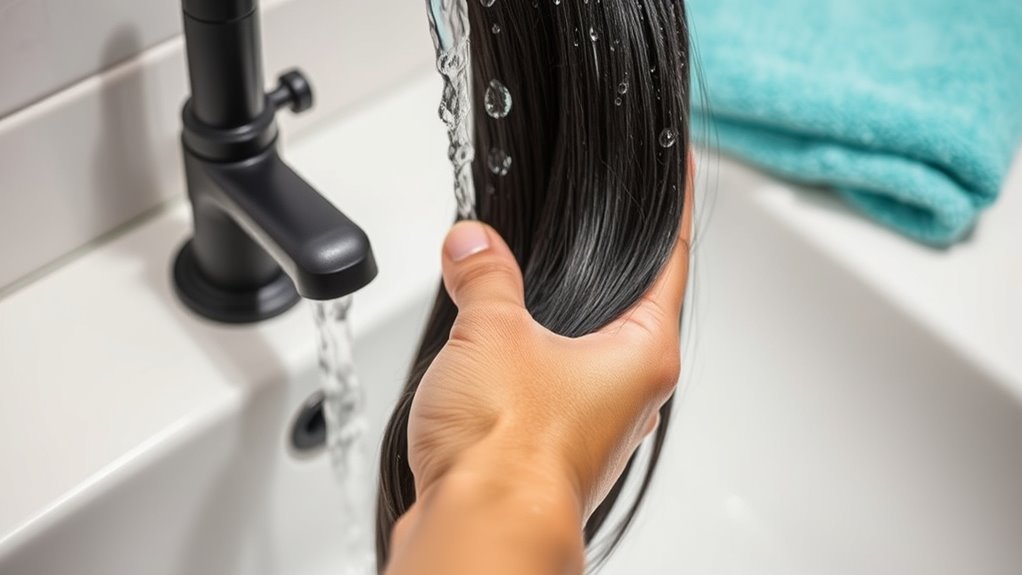
After you’ve rinsed out your deep conditioner, it’s important to follow up with proper post-conditioning care to lock in moisture and keep your hair healthy. Start by gently scalp exfoliation to remove product buildup and dead skin, promoting a healthier scalp and better absorption of nutrients. Once your scalp is clean, focus on moisture sealing by applying a lightweight leave-in conditioner or oil to lock in hydration. This step helps prevent moisture loss and keeps your hair soft and manageable. Be careful not to over-apply products, as this can weigh your hair down. Using the right earbuds for small ears can help you enjoy your hair care routine with minimal discomfort. Consistent rinsing and post-conditioning care create a strong foundation for maintaining deep conditioning results and ensuring your hair remains moisturized, shiny, and resilient.
Establishing a Consistent Schedule and Maintenance Tips
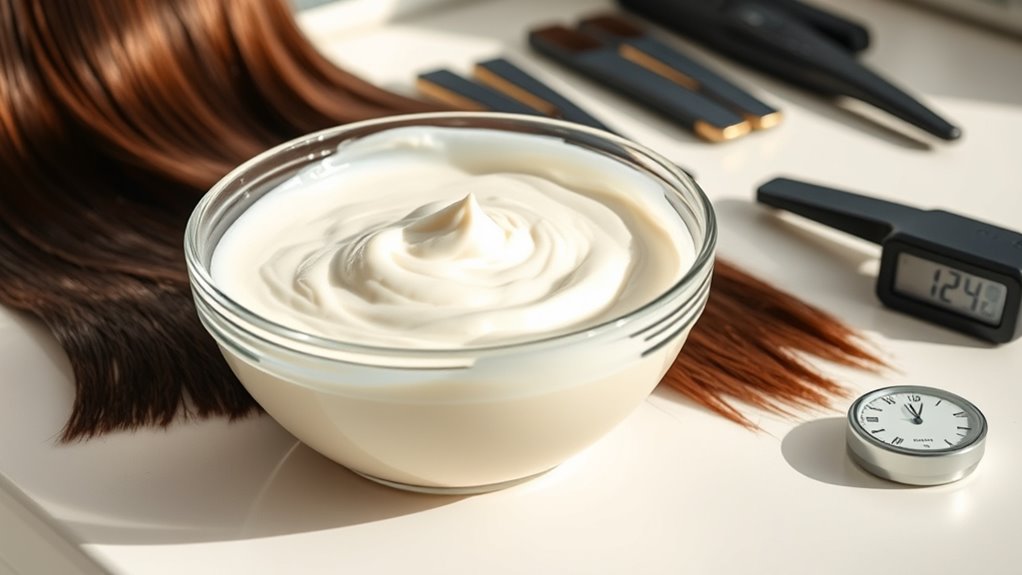
Maintaining healthy, moisturized hair requires more than just occasional deep conditioning; it’s about creating a routine you can stick to consistently. Understanding your hair porosity helps you determine how often to deep condition and tailor your schedule. For high porosity hair, weekly treatments work best, while low porosity hair might need bi-weekly sessions. Prioritizing scalp health is essential—clean, balanced scalp promotes better moisture retention. To stay consistent, set a reminder and track your routine. Use the table below as a guide:
| Hair Porosity | Maintenance Tip |
|---|---|
| High | Deep condition weekly |
| Low | Every 2 weeks |
| Normal | Every 2-3 weeks |
| Scalp health | Regular cleansing & moisturizing |
| Routine | Stick to your schedule daily |
Additionally, incorporating data analytics can help monitor the effectiveness of your routine and make adjustments as needed.
Frequently Asked Questions
How Often Should I Deep Condition for Best Results?
You should deep condition your hair every one to two weeks for best results, especially if you have high or low porosity hair. Adjust frequency based on your hair’s porosity and how it responds to product layering—more porous hair may need more frequent conditioning. Pay attention to your hair’s needs, and don’t hesitate to extend or shorten the routine to maintain moisture, shine, and overall health.
Can I Use Deep Conditioner on Color-Treated Hair?
Yes, you can use deep conditioner on color-treated hair, but choose one formulated for color protection. Look for products with safe ingredients that nourish without stripping color or causing damage. Make sure to read labels carefully to confirm ingredient safety. Using a gentle, color-safe deep conditioner regularly helps maintain your hair’s vibrancy, keeps it moisturized, and prevents fading, giving you healthy, beautiful color-treated hair.
What Ingredients Should I Avoid in Deep Conditioning Products?
You should avoid deep conditioning products with harmful chemicals like sulfates, parabens, and silicones, as these can damage your hair over time. Instead, look for natural alternatives that nourish without stripping moisture or causing buildup. Choose conditioners with ingredients like aloe vera, coconut oil, or argan oil, which are gentle yet effective. Reading labels helps make certain you’re using products that support healthy, vibrant hair without exposing it to unnecessary chemicals.
Does Deep Conditioning Work on All Hair Types Equally?
Deep conditioning works differently depending on your hair porosity and scalp sensitivity. If you have high porosity hair, you might need more frequent treatments for moisture retention. For sensitive scalps, choose gentle formulas that won’t cause irritation. You’ll notice better results when you tailor your deep conditioning routine to your hair’s unique needs, ensuring your hair stays healthy, hydrated, and manageable no matter your hair type.
How Do I Troubleshoot if My Hair Feels Greasy Afterward?
Did you know that about 50% of people experience scalp oiliness after deep conditioning? If your hair feels greasy afterward, it’s likely due to product buildup or excess scalp oiliness. To troubleshoot, rinse thoroughly to remove leftover product, reduce the amount of conditioner used, and avoid applying conditioner directly to your scalp. Using clarifying shampoos occasionally can also help prevent buildup and keep your hair feeling fresh.
Conclusion
By following this routine, you’ll nurture your hair’s natural beauty and keep it thriving. Embrace each step as a gentle rhythm, allowing your strands to flourish with care and patience. With consistency and attention, you’ll find your hair’s true glow shining through, whispering stories of health and vitality. Trust the process, and soon, your hair will thank you with every soft, radiant strand—your perfect deep conditioning journey, beautifully unfolding.









